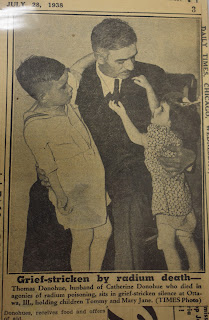Luminous: The Story of a Radium Girl
by Samantha Wilcoxson
A story of female friendship and strength set against corporate corruption.
Catherine's life is set on an unexpected course when she accepts a job at Radium Dial. She soon finds out that the excellent pay is no recompense for the evil secret that lurks in the magical glow-in-the-dark paint. Catherine Donohoe takes on the might of a big corporation and becomes an early pioneer of social justice in the era between world wars.
Emotive and inspiring - this book will touch you like no other as you witness the devastating impact of radium poisoning on young women's lives.
It’s too late for me, but maybe it will help some of the others.
~ Catherine Wolfe Donohue
by Samantha Wilcoxson
As a historical fiction author, one of the most common questions I am asked is 'How much of that story is true?' I strive for historical accuracy as much as possible and try to fill in the gaps in a way that fits with historical figures' personalities and circumstances. Since Luminous takes place in a much more recent era than my previous works, I was able to use source material from newspapers and personal letters.
If you have read Luminous, you know that each chapter begins with a historical quote from one of the people included in the novel or from a scientist or journalist of that era. I did this to consistently remind readers that this story is true. When you feel yourself getting angry at the actions (or lack thereof) of Radium Dial or you can't quite believe the suffering the women endured, remember that it is not a figment of my imagination.
One of the first and most priceless sources of material I discovered when researching Catherine's story were the newspaper articles archived by Len Grossman, son of Catherine's attorney, Leonard Grossman. Scrolling through the headlines feels surreal, and one can imagine the public's reaction at the time - those who felt the same anger and sympathy that we do today and those who supported the radium companies and assumed the women were lying to make a quick buck. I appreciated that these articles offered images of the women. I had real faces to attach to the familiar names. I discovered that Catherine had worn a polka-dot dress for one of her court appearances, and I insisted on having one on my book cover.
My next step was visiting Ottawa, Illinois, where Catherine lived her short life and worked at Radium Dial. The old schoolhouse that was home to Radium Dial was long gone - the material from its destruction having been spread around town and used for land fill, exacerbating the radiation problem that continues to plague the area. However, I was able to attend church at St Columba, where Catherine had been baptized and married. This was an important place to include in her story and it made me feel closer to her to be there. I was also able to climb Starved Rock and drive by the house she inherited from her aunt and uncle.
Today, Ottawa has a memorial to the dial painters who suffered and died due to the negligence of the radium industry. It isn't centrally located like the Lincoln-Douglas statue but sits on a quiet corner a bit away from the busier part of the historic downtown district. At first that made me a bit sad, but later I found it fitting. Catherine and her friends had never wanted to be the center of attention. They were forced into it.
Not far away from Ottawa, the LaSalle County Historical Museum holds the Pearl Payne collection. Again, readers of Luminous will remember that Pearl was one of Catherine's closest friends who outlived her by several decades though she also suffered effects of radium poisoning. This collection gave me the most intimate look into the women's lives as I read their correspondence, quotes from which I included in dialog of my novel. I'll never forget holding a letter written by Catherine where she begged Pearl to visit because she was 'so lonesome and blue.' Pearl also kept a collection of newspaper clippings and a record of the testing she underwent for study of the radium in her body. She kept telegrams from Leonard Grossman and a memorial card from Catherine's funeral.
Finally, I was able to locate - after much wandering and searching - Catherine Donohue's simple grave. It is located just outside town, near that of her husband, Tom, who never remarried. The historian part of my brain had expected something more monumental, but, like the downtown monument, I should not have been surprised that Catherine's memorial stone was simple and unobtrusive.
I wish I could have written Catherine a longer story. I wish she could have been healed and won a huge monetary settlement, but the truth of her story did not allow me to do so. That's the problem with history. It cannot be changed, but, hopefully, we learn from its lessons.
This title is available to read on #KindleUnlimited.
Samantha Wilcoxson
Samantha Wilcoxson is an author of emotive biographical fiction that enables readers to connect with history's unsung heroes. She also writes nonfiction for Pen & Sword History.
Samantha loves sharing trips to historic places with her family and spending time by the lake with a glass of wine. Her most recent work is Women of the American Revolution, which explores the lives of 18th century women, and she is currently working on a biography of James Alexander Hamilton.
Connect with Samantha:














No comments:
Post a Comment